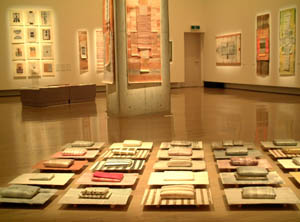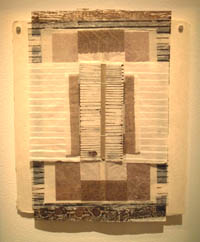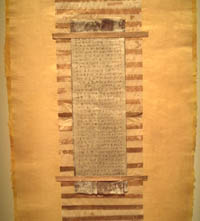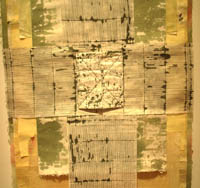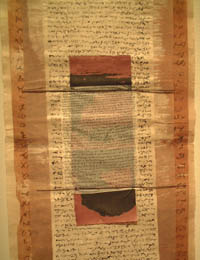As Above, So Below
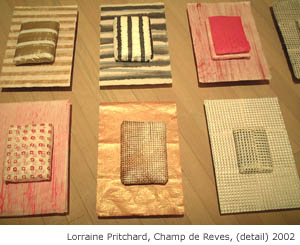
Paper is the prime material
of Lorraine Pritchard's art. Layers of paper -- patterned, folded, wrapped
and packaged form her work. She uses washi, thin Japanese rice papers
and applies paint and ink like a calligrapher-- sometimes thin spider-like
trails of script, while at others bold gestural brushstrokes. Pritchard
assembles her pieces by combining many sheets of washi and allowing the
semi-translucent paper to show through the patterns below. The title of
her exhibition refers to this layered construction of her work. It is
also connected with ideas of spirituality, 'above' and earthly materials,
'below' drawn from Pritchard's religious following of the Baha'i faith.
Pritchard combines her papers with sticks, fibers and other natural elements.
Her art is mixed cultures as well as media. She borrows both patterns
and material forms from various indigenous cultures. Straw, sticks and
string are reminiscent of North American Native Indian crafts, while the
use of repetitive patterning with dots echoes Australian Aboriginal artists
dotted paintings of their dessert lands. There is also a simple Japanese
aesthetic about her works. Pritchard, from a Canadian farming background,
combines all of these elements to create a sense of space reminiscent
of the prairies, her childhood home. 'Champ de Reves' (street of dreams)
is a lage floor work consisting of 25 pillows of paper. Each enigmatic
package is patterned in stripes or dots and rests on further sheets of
paper. The patchwork of patterns is given order through a gridded installation.
It is laid out in a square of 5X5. The work conjures up scenes of farming
fields seen from a plane above. Each square of land patterned by ploughing
ready for planting while a patchwork of other paddocks are coloured by
different crops yellowing in the sun or reveal lines of stock travel and
erosion. Natural tones are dominant in Pritchard's art. She uses earthy
tones of yellow and brown to evoke an ancient feeling. They are like tattered
cryptic maps to a spiritual treasure.
